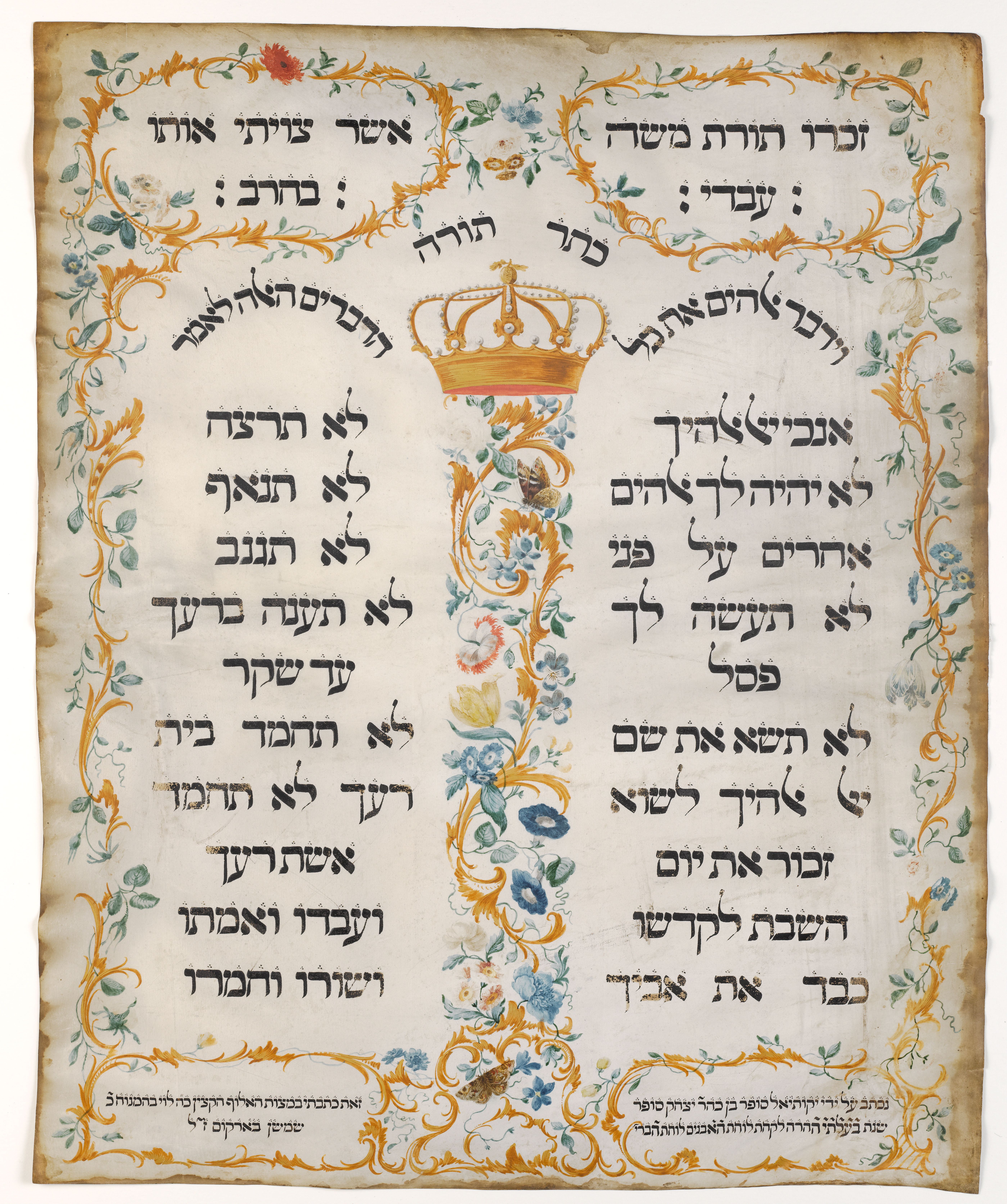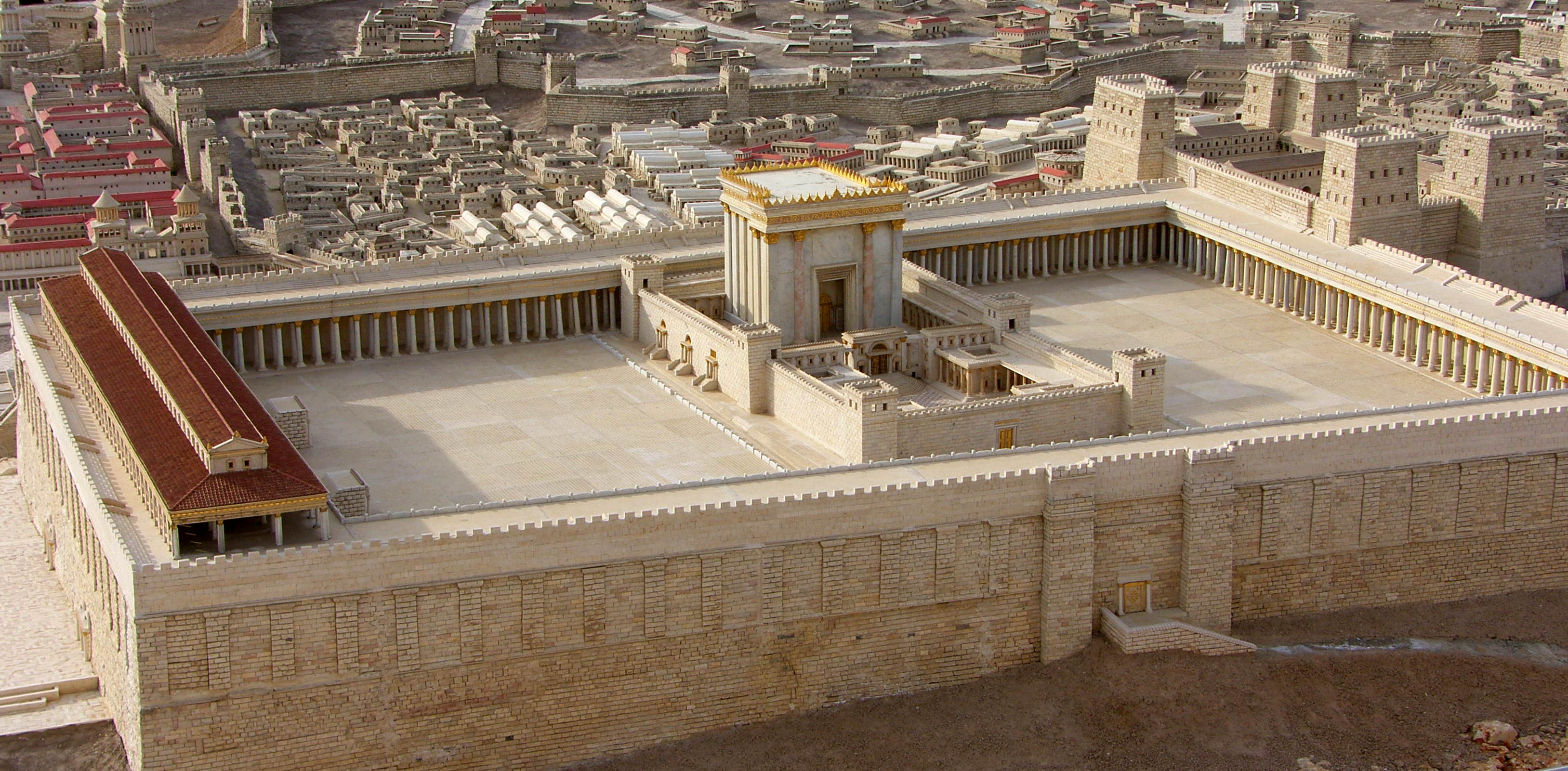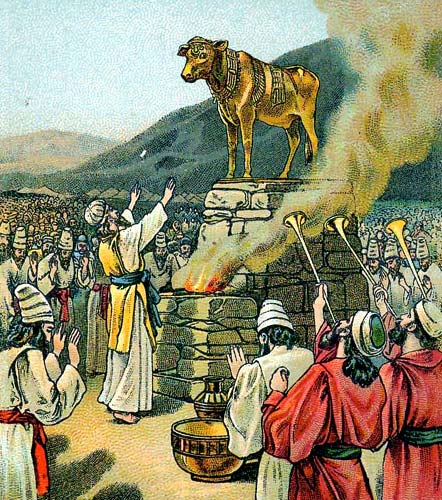|
Seventeenth Of Tammuz
The Seventeenth of Tammuz (, Modern: ''Shiv'á Asár beTammúz'', Tiberian ( SBL): ''Šib̲ʿāʿāśār bəṯammuz'')) is a Jewish fast day commemorating the breach of the walls of Jerusalem before the destruction of the Second Temple. It falls on the 17th day of the fourth Hebrew month of Tammuz and marks the beginning of The Three Weeks, a mourning period leading up to Tisha B'Av. The day also traditionally commemorates the destruction of the two tablets of the Ten Commandments and other historical calamities that befell the Jewish people on the same date. History The fast of Tammuz, according to Rabbi Akiva's interpretation, is the fast mentioned in the Book of Zechariah as "the fast of the fourth onth ( Zechariah 8:19). This refers to Tammuz, which is the fourth month of the Hebrew calendar. According to the Mishnah, five calamities befell the Jewish people on this day: #Moses broke the two tablets of stone on Mount Sinai, when he saw the Golden calf; #During the ... [...More Info...] [...Related Items...] OR: [Wikipedia] [Google] [Baidu] |
Tammuz (Hebrew Month)
Tammuz (Hebrew: , '), or Tamuz, is the tenth month of the civil year and the fourth month of the ecclesiastical year on the Hebrew calendar, and the modern Assyrian calendar. It is a month of 29 days, which occurs on the Gregorian calendar around June–July. The name of the month was adopted from the Assyrian and Babylonian month ''Araḫ Dumuzu'', named in honour of the Mesopotamian deity Dumuzid. Holidays 17 Tammuz – Seventeenth of Tammuz – is a fast day from 1 hour before sunrise to sundown in remembrance of Jerusalem's walls being breached. 17 Tammuz is the beginning of The Three Weeks, in which Jews follow similar customs as the ones followed during the Omer from the day following Passover until the culmination of the mourning for the death of the students of Rabbi Akiva (the 33rd day of the Omersuch as refraining from marriage and haircuts.) The Three Weeks culminate with Tisha B'Av (9th of Av). :Ashkenazi communities refrain from wine and meat from the be ... [...More Info...] [...Related Items...] OR: [Wikipedia] [Google] [Baidu] |
Ten Commandments
The Ten Commandments (), or the Decalogue (from Latin , from Ancient Greek , ), are religious and ethical directives, structured as a covenant document, that, according to the Hebrew Bible, were given by YHWH to Moses. The text of the Ten Commandments appears in three markedly distinct versions in the Bible: at Exodus , Deuteronomy , and the " Ritual Decalogue" of Exodus . The biblical narrative describes how God revealed the Ten Commandments to the Israelites at Mount Sinai amidst thunder and fire, gave Moses two stone tablets inscribed with the law, which he later broke in anger after witnessing the worship of a golden calf, and then received a second set of tablets to be placed in the Ark of the Covenant. Scholars have proposed a range of dates and contexts for the origins of the Decalogue. “Three main dating schemes have been proposed: (1) it was suggested that the Decalogue was the earliest legal code given at Sinai, with Moses as author, and the Amphictyony con ... [...More Info...] [...Related Items...] OR: [Wikipedia] [Google] [Baidu] |
Torah
The Torah ( , "Instruction", "Teaching" or "Law") is the compilation of the first five books of the Hebrew Bible, namely the books of Genesis, Exodus, Leviticus, Numbers and Deuteronomy. The Torah is also known as the Pentateuch () or the Five Books of Moses. In Rabbinical Jewish tradition it is also known as the Written Torah (, ). If meant for liturgic purposes, it takes the form of a Torah scroll ( '' Sefer Torah''). If in bound book form, it is called '' Chumash'', and is usually printed with the rabbinic commentaries (). In rabbinic literature, the word ''Torah'' denotes both the five books ( "Torah that is written") and the Oral Torah (, "Torah that is spoken"). It has also been used, however, to designate the entire Hebrew Bible. The Oral Torah consists of interpretations and amplifications which according to rabbinic tradition have been handed down from generation to generation and are now embodied in the Talmud and Midrash. Rabbinic tradition's underst ... [...More Info...] [...Related Items...] OR: [Wikipedia] [Google] [Baidu] |
Apostomus
Apostomus is a name occurring in Talmudic tradition. The Talmudic account Among five catastrophes said to have overtaken the Jews on the Seventeenth of Tammuz, the ''Mishnah'' includes "the burning of the Torah by Apostomus". Owing to this very vague mention, there is much difference of opinion as to the identity of Apostomus. At first glance he may be associated with one of the following two incidents: * Flavius Josephus relates that about the year 50 a Roman soldier seized a Torah-scroll and, with abusive and mocking language, burned it in public. This incident almost brought on a revolution; but the Roman procurator Cumanus appeased the Jewish populace by beheading the culprit. *The other incident of the burning of the Torah, which took place at the time of the Hadrianic Persecutions, is recounted by the rabbis. Ḥanania ben Teradyon, one of the most distinguished men of the time, was wrapped in a Torah-scroll and burned. In connection with this, a certain "philosopher" i ... [...More Info...] [...Related Items...] OR: [Wikipedia] [Google] [Baidu] |
Bar Kokhba's Revolt
The Bar Kokhba revolt (132–136 AD) was a major uprising by the Jews of Judaea against the Roman Empire, marking the final and most devastating of the Jewish–Roman wars. Led by Simon bar Kokhba, the rebels succeeded in establishing an independent Jewish state that lasted for several years. The revolt was ultimately crushed by the Romans, resulting in the near-depopulation of Judea through large-scale killings, mass enslavement, and the displacement of many Jews from the region. Resentment toward Roman rule in Judaea and nationalistic aspirations remained high following the destruction of Jerusalem during the First Jewish Revolt in 70 AD. The immediate triggers of the Bar Kokhba revolt included Emperor Hadrian's decision to build ''Aelia Capitolina''—a Roman colony dedicated to Jupiter—on the ruins of Jerusalem, extinguishing hopes for the Temple's reconstruction, as well as a possible ban on circumcision, a central Jewish practice. Unlike the earlier revolt, the rebels ... [...More Info...] [...Related Items...] OR: [Wikipedia] [Google] [Baidu] |
Siege Of Jerusalem (AD 70)
The siege of Jerusalem in 70 CE was the decisive event of the First Jewish–Roman War (66–73 CE), a major rebellion against Roman Empire, Roman rule in the province of Judaea (Roman province), Judaea. Led by Titus, Roman forces besieged the Jewish capital, which had become the main stronghold of the revolt. After months of fighting, they breached its defenses, destroyed the Second Temple, razed most of the city, and killed, enslaved, or displaced a large portion of its population. The fall of Jerusalem marked the effective end of the Jewish revolt and had far-reaching political, religious, and cultural consequences. In the winter of 69/70 CE, following a pause caused by the Year of the Four Emperors, Roman succession war, the campaign in Judaea resumed as Titus led at least 48,000 troops—including four Roman legion, legions and auxiliary forces—back into the province. By spring, this army had encircled Jerusalem, whose population had surged with refugees and Passover ... [...More Info...] [...Related Items...] OR: [Wikipedia] [Google] [Baidu] |
Korban
In Judaism, the (), also spelled or , is any of a variety of sacrificial offerings described and commanded in the Torah. The plural form is , , or . The term primarily refers to sacrificial offerings given from humans to God for the purpose of doing homage, winning favor, or securing pardon. The object sacrificed was usually an animal that was ritually slaughtered and then transferred from the human to the divine realm by being burned on an altar. Other sacrifices include grain offerings made of flour and oil, not meat. After the destruction of the Second Temple, sacrifices were prohibited because there was no longer a Temple, the only place allowed by halakha for sacrifices. Offering of sacrifices was briefly reinstated during the Jewish–Roman wars of the second century CE. When sacrifices were offered in ancient times, they were offered as a fulfillment of Biblical commandments. According to Orthodox Judaism, the coming of the messiah will not remove the require ... [...More Info...] [...Related Items...] OR: [Wikipedia] [Google] [Baidu] |
Siege Of Jerusalem (597 BC)
The siege of Jerusalem (597 BC) was a military campaign carried out by Nebuchadnezzar II, king of the Neo-Babylonian Empire, in which he besieged Jerusalem, then capital of the Kingdom of Judah. The city surrendered, and its king Jeconiah was deported to Babylon and replaced by his Babylonian-appointed uncle, Zedekiah. The siege is recorded in both the Hebrew Bible () and the Babylonian Nebuchadnezzar Chronicle. In 601 BC, Nebuchadnezzar II unsuccessfully attempted to take Egypt and was repulsed with heavy losses. Jehoiakim—the king of Judah—seized this opportunity to revolt against Babylonian rule, taking a pro-Egyptian position, despite the strong remonstrances of the prophet Jeremiah. The circumstances of Jehoiakim’s death are not clear. He was succeeded by his young son, Jeconiah. The Babylonians besieged Jerusalem, and in March 597 BC the city surrendered. Jeconiah, his court and other prominent citizens and craftsmen, were deported to Babylon. This event is co ... [...More Info...] [...Related Items...] OR: [Wikipedia] [Google] [Baidu] |
Ki Tissa
Ki Tisa, Ki Tissa, Ki Thissa, or Ki Sisa (—Hebrew for "when you take," the sixth and seventh words, and first distinctive words in the parashah) is the 21st weekly Torah portion (parashah) in the annual Jewish cycle of Torah reading and the ninth in the Book of Exodus. The parashah tells of building the Tabernacle, the incident of the Golden Calf, the request of Moses for God to reveal God's Attributes, and how Moses became radiant. The parashah constitutes Exodus 30:11–34:35. The parashah is the longest of the weekly Torah portions in the book of Exodus (although not the longest in the Torah, which is Naso), and is made up of 7,424 Hebrew letters, 2,002 Hebrew words, 139 verses, and 245 lines in a Torah scroll (''Sefer Torah''). Jews read it on the 21st Sabbath after Simchat Torah, in the Hebrew month of Adar, corresponding to February or March in the secular calendar. Jews also read the first part of the parashah, Exodus 30:11–16, regarding the half-shekel head tax, ... [...More Info...] [...Related Items...] OR: [Wikipedia] [Google] [Baidu] |
Tanchuma
Midrash Tanhuma (), also known as Yelammedenu, is the name given to a homiletic midrash on the entire Torah, and it is known in several different versions or collections. Tanhuma bar Abba is not the author of the text but instead is a figure to whom traditions are frequently attributed to (indicated by the formula "Thus began R. Tanḥuma" or "Thus preached R. Tanḥuma"), though he may have preserved a collection of midrashim used by other midrash editors. The name ''Yelammedenu'' derives from the Hebrew phrase ''yelammedenu rabbenu'', which initiates a typical textual unit in the text. The earliest manuscript may be from the late 8th or 9th century. The most significant publication on the text so far was an edited volume of studies by Nikolsky and Atzmon from 2022. Recensions There are many different recensions of Midrash Tanhuma, although the main ones are the standard printed edition, first published in Constantinople in 1520/1522 (and then again in Venice in 1545 and Mantua ... [...More Info...] [...Related Items...] OR: [Wikipedia] [Google] [Baidu] |
Golden Calf
According to the Torah, the Bible, and the Quran, the golden calf () was a cult image made by the Israelites when Moses went up to Mount Sinai (bible), Mount Sinai. In Hebrew, the incident is known as "the sin of the calf" (). It is first mentioned in the Book of Exodus. Sacred bull, Bull worship was common in many cultures. In Ancient Egypt, Egypt, whence according to the Exodus narrative, the Israelites had recently come, the bull-god Apis (deity), Apis was a comparable object of worship, which some believe the Hebrews were reviving in the wilderness. Alternatively, some believe Yahweh, the national god of the Israelites, was associated with or pictured as a sacred bull through the process of religious assimilation and syncretism. Among the Canaan, Canaanites, some of whom would become the Israelites, the bull was widely worshipped as the sacred bull and the creature of El (deity), El. Biblical narrative When Moses went up Mount Sinai (Bible), Mount Sinai to receive the Ten C ... [...More Info...] [...Related Items...] OR: [Wikipedia] [Google] [Baidu] |
Mishnah
The Mishnah or the Mishna (; , from the verb ''šānā'', "to study and review", also "secondary") is the first written collection of the Jewish oral traditions that are known as the Oral Torah. Having been collected in the 3rd century CE, it is the first work of rabbinic literature, written primarily in Mishnaic Hebrew but also partly in Jewish Palestinian Aramaic. The oldest surviving physical fragments of it are from the 6th to 7th centuries. The Mishnah was literary redaction, redacted by Judah ha-Nasi probably in Beit She'arim (Roman-era Jewish village), Beit Shearim or Sepphoris between the ending of the second century CE and the beginning of the third century. Heinrich Graetz, dissenting, places the Mishnah's compilation in 189 CE (see: H. Graetz, ''History of the Jews'', vol. 6, Philadelphia 1898, p105), and which date follows that penned by Rabbi Abraham ben David in his "Sefer HaKabbalah le-Ravad", or what was then ''anno'' 500 of the Seleucid era. in a time when the p ... [...More Info...] [...Related Items...] OR: [Wikipedia] [Google] [Baidu] |








